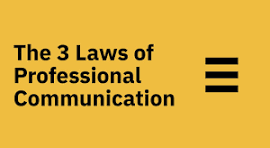The 3 Laws of Professional Communications
By wchung | 26 Nov, 2025
How to grab serious attention for your brilliant messages. by Landy Mak
Spend hours writing well-researched memos that get ignored?
Make brilliant suggestions that make people’s eyes glaze over?
Send magnificent proposals that clients don’t read?
You are surely breaking one or more of the 3 Laws of Professional Communications.
Trying to make an impression without observing these laws is like trying to make water flow uphill without a pump. But obey these simple laws in every presentation and your audience will drink in your words like manna from heaven.
1. Lead with the question on everyone’s mind.
- How do we slash 35% from our widget production budget without sacrificing speed and quality?
- How do we double weekday traffic without cannibalizing our high-margin weekend traffic?
- How do we make your customers buy now instead of waiting until next year?
Every business communication must have a worthwhile purpose. Otherwise why would anyone waste precious time trying to absorb it? Remember that it takes precious energy to digest a piece of information, especially if it’s some brilliant idea no one has yet considered. That’s why you must lead with the question on everyone’s mind. It reassures them right up front that you are down with them, and therefore, may say something worth heeding. If you can’t articulate a killer question with which to lead your presentation, you probably have nothing worth listening to. In that case, keep quiet and save your credibility for when you do.
2. Follow with the short answer.
- Let’s outsource the widget line to our competitor.
- Let’s deliver coupons to people in the neighborhood.
- Let’s add an expiration date to your offers.
Articulating the big question earns you about three seconds. That isn’t enough time to start in on a long boring rampup to your main idea. It’s those long rampups that make people’s eyes glaze over as their minds wander. People in the professional world operate on the attention spans of squirrels. So lose no time in spitting out the essence of your idea in one clear, crisp sentence. If you can’t get it down to a quick sentence you probably don’t have an idea worth communicating in the real world.
3. Present your three strongest arguments.
- Our competitor makes better quality widgets than we do.
- Our labor costs are going through the roof.
- Outsourcing will free up our best people for expanding distribution where the real action is.
Only novices try to present everything in one fell swoop. In real life that first suggestion, memo or proposal is typically the starting point for followup discussions, emails, calls, memoes. Great communicators never forget the short attention spans of their audience. Three points is about all most people can absorb in a single sitting, so why risk turning them off altogether by piling on everything you can think of? Do the tough job of picking which three to present first. Keep in mind that it never hurts to save some juicy stuff for the followup communications that will surely follow. Meaningful communication always becomes a two-way street.
In closing, communication is all about grabbing and holding attention. Without it your brilliance will never see the light of day.
"If you can't articulate a killer question with which to lead your presentation, you probably have nothing worth listening to."

Asian American Success Stories
- The 130 Most Inspiring Asian Americans of All Time
- 12 Most Brilliant Asian Americans
- Greatest Asian American War Heroes
- Asian American Digital Pioneers
- New Asian American Imagemakers
- Asian American Innovators
- The 20 Most Inspiring Asian Sports Stars
- 5 Most Daring Asian Americans
- Surprising Superstars
- TV’s Hottest Asians
- 100 Greatest Asian American Entrepreneurs
- Asian American Wonder Women
- Greatest Asian American Rags-to-Riches Stories
- Notable Asian American Professionals

